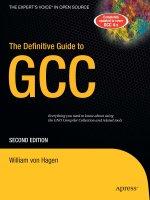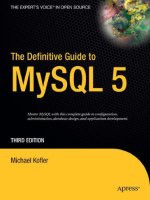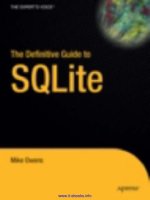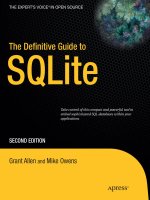the definitive guide to the xen hypervisor
Bạn đang xem bản rút gọn của tài liệu. Xem và tải ngay bản đầy đủ của tài liệu tại đây (2.26 MB, 307 trang )
The Definitive Guide
to the
Xen Hypervisor
Prentice Hall
Open Source Software Development Series
Arnold Robbins, Series Editor
“Real world code from real world applications”
Open Source technology has revolutionized the computing world. Many large-scale projects are in
production use worldwide, such as Apache, MySQL, and Postgres, with programmers writing applications
in a variety of languages including Perl, Python, and PHP. These technologies are in use on many different
systems, ranging from proprietary systems, to Linux systems, to traditional UNIX systems, to mainframes.
The Prentice Hall Open Source Software Development Series is designed to bring you the best of these
Open Source technologies. Not only will you learn how to use them for your projects, but you will learn
from them. By seeing real code from real applications, you will learn the best practices of Open Source
developers the world over.
Titles currently in the series include:
Linux
®
Debugging and Performance Tuning
Steve Best
0131492470, Paper, ©2006
The Defi nitive Guide to the Xen Hypervisor
David Chisnall
013234971X, Hard, ©2008
Understanding AJAX
Joshua Eichorn
0132216353, Paper, ©2007
The Linux Programmer’s Toolbox
John Fusco
0132198576, Paper, ©2007
Embedded Linux Primer
Christopher Hallinan
0131679848, Paper, ©2007
The Apache Modules Book
Nick Kew
0132409674, Paper, © 2007
SELinux by Example
Frank Mayer, David Caplan, Karl MacMillan
0131963694, Paper, ©2007
UNIX to Linux® Porting
Alfredo Mendoza, Chakarat Skawratananond,
Artis Walker
0131871099, Paper, ©2006
Rapid Web Applications with TurboGears
Mark Ramm, Kevin Dangoor, Gigi Sayfan
0132433885, Paper, © 2007
Linux Programming by Example
Arnold Robbins
0131429647, Paper, ©2004
The Linux
®
Kernel Primer
Claudia Salzberg, Gordon Fischer,
Steven Smolski
0131181637, Paper, ©2006
Rapid GUI Programming with Python and Qt
Mark Summerfi eld
0132354187, Hard, © 2008
New to the series: Digital Short Cuts
Short Cuts are short, concise, PDF documents designed specifi cally for busy technical professionals like
you. Each Short Cut is tightly focused on a specifi c technology or technical problem. Written by industry
experts and best selling authors, Short Cuts are published with you in mind — getting you the technical
information that you need — now.
Understanding AJAX:
Consuming the Sent Data with XML and JSON
Joshua Eichorn
0132337932, Adobe Acrobat PDF, © 2007
Debugging Embedded Linux
Christopher Hallinan
0131580132, Adobe Acrobat PDF, © 2007
Using BusyBox
Christopher Hallinan
0132335921, Adobe Acrobat PDF, © 2007
The Definitive Guide
to the
Xen Hypervisor
David Chisnall
Upper Saddle River, NJ • Boston • Indianapolis • San Francisco
New York • Toronto • Montreal • London • Munich • Paris • Madrid
Capetown • Sydney • Tokyo • Singapore • Mexico City
Many of the designations used by manufacturers and sellers to distinguish their products are
claimed as trademarks. Where those designations appear in this book, and the publisher was
aware of a trademark claim, the designations have been printed with initial capital letters or
in all capitals.
Xen, XenSource, XenEnterprise, XenServer and XenExpress, are either registered trademarks
or trademarks of XenSource Inc. in the United States and/or other countries.
The author and publisher have taken care in the preparation of this book, but make no
expressed or implied warranty of any kind and assume no responsibility for errors or omissions.
No liability is assumed for incidental or consequential damages in connection with or arising
out of the use of the information or programs contained herein.
The publisher offers excellent discounts on this book when ordered in quantity for bulk pur-
chases or special sales, which may include electronic versions and/or custom covers and con-
tent particular to your business, training goals, marketing focus, and branding interests. For
more information, please contact: U.S. Corporate and Government Sales, (800) 382-3419,
For sales outside the United States please contact: Inter-
national Sales,
Visit us on the Web: www.prenhallprofessional.com
Library of Congress Cataloging-in-Publication Data
Chisnall, David.
The definitive guide to the Xen hypervisor / David Chisnall.
p. cm.
Includes index.
ISBN-13: 978-0-13-234971-0 (hardcover : alk. paper) 1. Xen
(Electronic resource) 2. Virtual computer systems. 3. Computer
organization. 4. Parallel processing (Electronic computers) I. Title.
QA76.9.V5C427 2007
005.4’3—dc22
2007036152
Copyright
c
2008 Pearson Education, Inc.
All rights reserved. Printed in the United States of America. This publication is protected by
copyright, and permission must be obtained from the publisher prior to any prohibited repro-
duction, storage in a retrieval system, or transmission in any form or by any means, electronic,
mechanical, photocopying, recording, or likewise. For information regarding permissions, write
to: Pearson Education, Inc., Rights and Contracts Department, 501 Boylston Street, Suite
900, Boston, MA 02116; fax: (617) 671-3447.
ISBN-13: 978-0-13-234971-0
ISBN-10: 0-13-234971-X
Text printed in the United States on recycled paper at Courier in Westford, Massachusetts.
First printing, November 2007
Editor-in-Chief
Mark L. Taub
Acquisitions Editor
Debra Williams Cauley
Development Editor
Michael Thurston
Managing Editor
John Fuller
Full-Service Production
Manager
Julie B. Nahil
Technical Reviewer
Glenn Tremblay
Cover Designer
Alan Clements
Composition
David Chisnall
Contents
List of Figures xi
List of Tables xiii
For ewor d xv
Preface xvii
I The Xen Virtual Machine 1
1 The State of Virtualization 3
1.1 WhatIsVirtualization? 3
1.1.1 CPUVirtualization 4
1.1.2 I/OVirtualization 5
1.2 WhyVirtualize? 7
1.3 TheFirstVirtualMachine 8
1.4 TheProblemofx86 9
1.5 SomeSolutions 9
1.5.1 BinaryRewriting 10
1.5.2 Paravirtualization 10
1.5.3 Hardware-AssistedVirtualization 13
1.6 TheXenPhilosophy 15
1.6.1 SeparationofPolicyandMechanism 15
1.6.2 LessIsMore 15
1.7 TheXenArchitecture 16
1.7.1 The Hypervisor, the OS, and the Applications . . . . . . . 16
1.7.2 The RˆoleofDomain0 19
1.7.3 Unprivileged Domains 22
1.7.4 HVMDomains 22
1.7.5 XenConfigurations 23
v
vi Contents
2 Exploring the Xen Virtual Architecture 27
2.1 BootingasaParavirtualizedGuest 27
2.2 RestrictingOperationswithPrivilegeRings 28
2.3 ReplacingPrivilegedInstructionswithHypercalls 30
2.4 ExploringtheXenEventModel 33
2.5 CommunicatingwithSharedMemory 34
2.6 SplitDeviceDriverModel 35
2.7 TheVMLifecycle 37
2.8 Exercise:TheSimplestXenKernel 38
2.8.1 TheGuestEntryPoint 40
2.8.2 PuttingItAllTogether 43
3 Understanding Shared Info Pages 47
3.1 RetrievingBootTimeInfo 47
3.2 TheSharedInfoPage 51
3.3 TimeKeepinginXen 53
3.4 Exercise:Implementinggettimeofday() 54
4 Using Grant Tables 59
4.1 SharingMemory 59
4.1.1 MappingaPageFrame 61
4.1.2 Transferring Data between Domains . . . 63
4.2 DeviceI/ORings 65
4.3 GrantingandRevokingPermissions 66
4.4 Exercise:MappingaGrantedPage 69
4.5 Exercise:SharingMemorybetweenVMs 71
5 Understanding Xen Memory Management 75
5.1 ManagingMemorywithx86 75
5.2 Pseudo-PhysicalMemoryModel 78
5.3 Segmentingon32-bitx86 80
5.4 UsingXenMemoryAssists 82
5.5 Controlling Memory Usage with the Balloon Driver . . . 84
5.6 OtherMemoryOperations 86
5.7 UpdatingthePageTables 89
5.7.1 CreatingaNewVMInstance 93
5.7.2 HandlingaPageFault 94
5.7.3 Suspend,Resume,andMigration 94
5.8 Exercise:MappingtheSharedInfoPage 95
Contents vii
II Device I/O 97
6 Understanding Device Drivers 99
6.1 TheSplitDriverModel 100
6.2 MovingDriversoutofDomain0 102
6.3 UnderstandingSharedMemoryRingBuffers 103
6.3.1 Examining the Xen Implementation 105
6.3.2 OrderingOperationswithMemoryBarriers 107
6.4 ConnectingDeviceswithXenBus 109
6.5 Handling Notifications from Events . 111
6.6 ConfiguringviatheXenStore 112
6.7 Exercise:TheConsoleDevice 112
7 Using Event Channels 119
7.1 EventsandInterrupts 119
7.2 HandlingTraps 120
7.3 EventTypes 123
7.4 RequestingEvents 124
7.5 BindinganEventChanneltoaVCPU 127
7.6 OperationsonBoundChannels 128
7.7 Getting a Channel’s Status . 129
7.8 MaskingEvents 130
7.9 EventsandScheduling 132
7.10Exercise:AFullConsoleDriver 133
8 Looking through the XenStore 141
8.1 TheXenStoreInterface 141
8.2 NavigatingtheXenStore 142
8.3 TheXenStoreDevice 145
8.4 ReadingandWritingaKey 147
8.4.1 TheUserspaceWay 148
8.4.2 FromtheKernel 150
8.5 OtherOperations 158
9 Supporting the Core Devices 161
9.1 TheVirtualBlockDeviceDriver 161
9.1.1 SettingUptheBlockDevice 162
9.1.2 Data Transfer . 165
9.2 UsingXenNetworking 169
9.2.1 TheVirtualNetworkInterfaceDriver 169
9.2.2 SettingUptheVirtualInterface 169
9.2.3 Sending and Receiving 170
viii Contents
9.2.4 NetChannel2 174
10 Other Xen Devices 177
10.1CDSupport 177
10.2VirtualFrameBuffer 178
10.3TheTPMDriver 183
10.4 Native Hardware . . . 184
10.4.1 PCISupport 184
10.4.2 USBDevices 186
10.5AddingaNewDeviceType 187
10.5.1 AdvertisingtheDevice 187
10.5.2 SettingUpRingBuffers 188
10.5.3 Difficulties 189
10.5.4 AccessingtheDevice 191
10.5.5 DesigningtheBackEnd 191
III Xen Internals 195
11 The Xen API 197
11.1XML-RPC 198
11.1.1 XML-RPC Data Types . . . 198
11.1.2 RemoteProcedureCalls 199
11.2ExploringtheXenInterfaceHierarchy 200
11.3TheXenAPIClasses 201
11.3.1 TheCBindings 203
11.4TheFunctionofXend 206
11.5XmCommandLine 208
11.6XenCIMProviders 209
11.7Exercise:EnumeratingRunningVMs 210
11.8Summary 215
12 Virtual Machine Scheduling 217
12.1OverviewoftheSchedulerInterface 218
12.2HistoricalSchedulers 219
12.2.1 SEDF 221
12.2.2 CreditScheduler 222
12.3UsingtheSchedulerAPI 224
12.3.1 RunningaScheduler 225
12.3.2 Domain0Interaction 228
12.4Exercise:AddingaNewScheduler 229
12.5Summary 233
Contents ix
13 HVM Support 235
13.1RunningUnmodifiedOperatingSystems 235
13.2IntelVT-xandAMDSVM 237
13.3HVMDeviceSupport 239
13.4HybridVirtualization 240
13.5EmulatedBIOS 244
13.6DeviceModelsandLegacyI/OEmulation 245
13.7ParavirtualizedI/O 246
13.8HVMSupportinXen 248
14 Future Directions 253
14.1 Real to Virtual, and Back Again . . 253
14.2EmulationandVirtualization 254
14.3PortingEfforts 255
14.4TheDesktop 257
14.5PowerManagement 259
14.6TheDomain0Question 261
14.7StubDomains 263
14.8NewDevices 264
14.9UnusualArchitectures 265
14.10TheBigPicture 267
IV Appendix 271
PV Guest Porting Cheat Sheet 273
A.1 DomainBuilder 273
A.2 BootEnvironment 274
A.3 SettingUptheVirtualIDT 274
A.4 PageTableManagement 275
A.5 Drivers 276
A.6 Domain0Responsibilities 276
A.7 Efficiency 277
A.8 Summary 278
Index 279
This page intentionally left blank
List of Figures
1.1 AninstructionstreaminaVM 11
1.2 Systemcallsinnativeandparavirtualizedsystems 12
1.3 Ringusageinnativeandparavirtualizedsystems 17
1.4 Ringusageinx86-64nativeandparavirtualizedsystems 18
1.5 The path of a packet sent from an unprivileged guest through the
system 20
1.6 AsimpleXenconfiguration 24
1.7 A Xen configuration showing driver isolation and an unmodified
guestOS 25
1.8 AsinglenodeinaclusteredXenenvironment 25
2.1 Thelifecycleofarealmachine 37
2.2 Thelifecycleofavirtualmachine 38
3.1 Thehierarchyofstructuresusedforthesharedinfopage 51
4.1 ThestructureofanI/Oring 67
5.1 ThethreelayersofXenmemory 80
5.2 Memorylayoutonx86systems 81
6.1 Thecompositionofasplitdevicedriver 101
6.2 Asequenceofactionsonaringbuffer 104
7.1 Theprocessofdeliveringanevent 131
11.1TheXeninterfacehierarchy 201
11.2Objectsassociatedwithahost 202
11.3ObjectsassociatedwithaVMinstance 203
xi
This page intentionally left blank
List of Tables
2.1 Xen components and their UNIX counterparts . 34
4.1 Granttablestatuscodes 63
5.1 Segmentdescriptorsonx86 76
5.2 AvailableVMassists 84
5.3 ExtendedMMUoperationcommands 92
7.1 Event channel status values . 130
xiii
This page intentionally left blank
Foreword
With the recent release of Xen 3.1 the Xen community has delivered the world’s
most advanced hypervisor, which serves as an open source industry standard for
virtualization. The Xen community benefits from the support of over 20 of the
world’s leading IT vendors, contributions from vendors and research groups world-
wide, and is the driving force of innovation in virtualization in the industry.
The continued growth and excellence of Xen is a vindication of the project’s
component strategy. Rather than developing a complete open source product, the
project endorses an integrated approach whereby the Xen hypervisor is included as
the virtualization “engine” in multiple products and projects. For example, Xen
is delivered as an integrated hypervisor with many operating systems, including
Linux, Solaris, and BSD, and is also packaged as virtualizaton platforms such as
XenSource’s XenEnterprise. This allows Xen to serve many different use cases
and customer needs for virtualization.
Xen supports a wide range of architectures, from super-computer systems with
thousands of Intel Itanium CPUs, to Power PC and industry standard x86 servers
and clients, and even ARM-9 based PDAs. The project’s cross-architecture, multi-
OS approach to virtualization is another of its key strengths, and has enabled it to
influence the design of proprietary products, including the forthcoming Microsoft
Windows Hypervisor, and benefit from hardware-assisted virtualization technolo-
gies from CPU, chipset, and fabric vendors. The project also works actively in
the DMTF, to develop industry standard management frameworks for virtualized
systems.
The continued success of the Xen hypervisor depends substantially on the
development of a highly skilled community of developers who can both contribute
to the project and use the technology within their own products. To date, other
than the community’s limited documentation, and a steep learning curve for the
uninitiated, Xen has retained a mystique that is unmistakably “cool” but not
scalable. While there are books explaining how to use Xen in the context of
particular vendors’ products, there is a huge need for a definitive technical insider’s
guide to the Xen hypervisor itself. Continuing the “engine” analogy, there are
books available for “cars” that integrate Xen, but no manuals on how to fix the
xv
xvi Foreword
“engine.” The publication of this book is therefore of great importance to the
Xen community and the industry of vendors around it.
David Chisnall brings to this project the deep systems expertise that is required
to dive deep inside Xen, understand its complex subsystems, and document its
workings. With a Ph.D. in computer science, and as an active systems software
developer, David has concisely distilled the complexity of Xen into a work that
will allow a skilled systems developer to get a firm grip on how Xen works, how
it interfaces to key hardware systems, and even how to develop it. To complete
his work, David spent a considerable period of time with the XenSource core
team in Cambridge, U.K., where he developed a unique insight into the history,
architecture, and inner workings of Xen. Without doubt his is the most thorough
in-depth book on the Xen hypervisor available, and fully merits its description as
the definitive insider’s guide.
It is my hope and belief that this work will contribute significantly to the con-
tinued development of the Xen project, and the adoption of Xen worldwide. The
opportunity for open source virtualization is huge, and the open source commu-
nity is the foundation upon which rapid innovation and delivery of differentiated
solutions is founded. The Xen community is leading the industry forward in vir-
tualization, and this book will play an important role in helping it to grow and
develop both the Xen hypervisor and products that deliver it to market.
Ian Pratt
Xen Project Lead and Founder of XenSource
Preface
This book aims to serve as a guide to the Xen hypervisor. The interface to
paravirtualized guests is described in detail, along with some description of the
internals of the hypervisor itself.
Any book about an open source project will, by nature, be less detailed than
the code of the project that it attempts to describe. Anyone wishing to fully un-
derstand the Xen hypervisor will find no better source of authoritative information
than the code itself. This book aims to provide a guided tour, indicating features
of interest to help visitors find their way around the code. As with many travel
books, it is to be hoped that readers will find it an informative read whether or
not they visit the code.
Much of the focus of this book is on the kernel interfaces provided by Xen.
Anyone wishing to write code that runs on the Xen hypervisor will find this mate-
rial relevant, including userspace program developers wanting to take advantage
of hypervisor-specific features.
Overview and Organization
This book is divided into three parts. The first two describe the hypervisor inter-
faces, while the last looks inside Xen itself.
Part I begins with a description of the history and current state of virtualiza-
tion, including the conditions that caused Xen to be created, and an overview of
the design decisions made by the developers of the hypervisor. The remainder of
this part describes the core components of the virtual environment, which must
be supported by any non-trivial guest kernel.
The second part focuses on device support for paravirtualized and
paravirtualization-aware kernels. Xen provides an abstract interface to devices,
built on some core communication systems provided by the hypervisor. Virtual
equivalents of interrupts and DMA and the mechanism used for device discov-
ery are all described in Part II, along with the interfaces used by specific device
categories.
xvii
xviii Preface
Part III takes a look at how the management tools interact with the hypervisor.
It looks inside Xen to see how it handles scheduling of virtual machines, and how
it uses CPU-specific features to support unmodified guests.
An appendix provides a quick reference for people wishing to port operating
systems to run atop Xen.
Typographical Conventions
This book uses a number of different typefaces and other visual hints to describe
different types of material.
Filenames, such as /bin/sh,areallshowninthis font. This same convention
is also used for structures which closely resemble a filesystem, such as paths in
the XenStore.
Variable or function names, such as example()
,usedintextwillbetypeset
like this .Registers,suchas
EAX, and instructions, such as POP will be shown
in uppercase lettering. Single line listings will appear like this:
eg = example function(arg1) ;
Longer listings will have line numbers down the left, and a gray background, as
shown in Listing 1. In all listings, bold is used to indicate keywords, and italicized
text represents strings and comments.
Listing 1: An example listing
[from: example/hello.c]
1 #include <stdio .h>
2
3 int main( void)
4 {
5 /∗ Print hello world ∗/
6 printf(”Hello World! \ n”);
7 return 0;
8 }
Listings which are taken from external files will retain the line numbers of the
original file, allowing the referenced section to be found easily by the reader. The
captions contain the original source in square brackets. Those beginning with
example/ are from the example sources. All others, unless otherwise specified,
are from the Xen sources.
Comments from files in the Xen source code have been preserved, complete
with errors. Since the Xen source code predominantly uses U.K. English for
comments, and variable and function names, this convention has been preserved
in examples from this book.
During the course of this book, a simple example kernel is constructed. The
source code for this can be downloaded from:
Preface xix
/>Output from command-line interaction is shown in the following way:
$ gcc hello.c
$ ./a.out
Hello World!
A $ prompt indicates commands that can be run as any user, while a # is used
to indicate that root access is likely to be required.
Use as a Text
In addition to the traditional uses for hypervisors, Xen makes an excellent teaching
tool. Early versions of Xen only supported paravirtualized guests, and newer ones
continue to support these in addition to unmodified guests. The architecture
exposed by the hypervisor to paravirtualized guests is very similar to x86, but
differs in a number of ways. Driver support is considerably easier, with a single
abstract device being exposed for each device category, for example. In spite of
this, a number of things are very similar. A guest operating system must handle
interrupts (or their virtual equivalent), manage page tables, schedule running
tasks, etc.
This makes Xen an excellent platform for development of new operating sys-
tems. Unlike a number of simple emulated systems, a guest running atop Xen
can achieve performance within 10% that of the native host. The simple device
interfaces make it easy for Xen guests to support devices, without having to worry
about the multitude of peripherals available for real machines.
The similarity to real hardware makes Xen an ideal platform for teaching op-
erating systems concepts. Writing a simple kernel that runs atop Xen is a signifi-
cantly easier task than writing one that runs on real hardware, and significantly
more rewarding than writing one that runs in a simplified machine emulator.
An operating systems course should use this text in addition to a text on
general operating systems principles to provide the platform-specific knowledge
required for students to implement their own kernels.
Xen is also a good example of a successful, modern, microkernel (although it
does more in kernelspace than many microkernels), making it a good example for
contrasting with popular monolithic systems.
Acknowledgments
First, I have to thank Mark Taub for the opportunity to write this book. Since
first contacting Mark in 2002, he has given me the opportunity to work on several
xx Preface
projects. This included working with Mark Sobell, from whom I learned a lot
about writing.
I also have to thank Debra Williams Cauley who coordinated everything for
this book, along with the rest of her team who helped to transform it into the
form you are now seeing.
I began writing this book near the end of the third year of my Ph.D., and
would like to thank my supervisor, Professor Min Chen, for his forbearance when
my thesis became a lower priority than getting this book finished. I would also
like to thank the other members of the Swansea University Computer Science
Department who kept me supplied with coffee while I was writing.
For technical assistance, I could have had no one more patient than Keir Fraser
whoansweredmyquestionsingreatdetailbyemailandinpersonwhenIvisited
XenSource. Without his help, this book would have taken a lot longer to write.
A number of other people at XenSource and at the Spring 2007 XenSummit also
provided valuable advice. I’d like to thank all of the people doing exciting things
with Xen for helping to make this book so much fun to write.
I would also like to thank Glenn Tremblay of Marathon Technologies Corp.
who performed a detailed technical review. While I can’t guarantee that this
book is error free, I can be very sure it wouldn’t have been without his assistance.
Glenn is a member of a growing group of people using Xen as a foundation for
their own products, and I hope his colleagues find this book useful.
This book was written entirely in Vim. Subversion was used for revision track-
ing and the final manuscript was typeset using L
A
T
E
X. Without the work of Bram
Moolenaar, Leslie Lamport, Donald Knuth, and many others, writing a book using
Free Software would be much harder, if not impossible.
Finally, I would like to thank all of the members of the Slashdot community
for helping me to procrastinate when I should have been writing.
Part I
The Xen Virtual Machine
This page intentionally left blank
Chapter 1
The State of Virtualization
Xen is a virtualization tool, but what does this mean? In this chapter, we will
explore some of the history of virtualization, and some of the reasons why people
found, and continue to find, it useful. We will have a look in particular at the
x86, or IA32, architecture, why it presents such a problem for virtualization, and
some possible ways around these limitations from other virtualization systems and
finally from Xen itself.
1.1 What Is Virtualization?
Virtualization is very similar conceptually to emulation. With emulation, a system
pretends to be another system. With virtualization, a system pretends to be two
or more of the same system.
Most modern operating systems contain a simplified system of virtualization.
Each running process is able to act as if it is the only thing running. The CPUs
and memory are virtualized. If a process tries to consume all of the CPU, a modern
operating system will preempt it and allow others their fair share. Similarly, a
running process typically has its own virtual address space that the operating
system maps to physical memory to give the process the illusion that it is the
only user of RAM.
Hardware devices are also often virtualized by the operating system. A process
can use the Berkeley Sockets API, or an equivalent, to access a network device
without having to worry about other applications. A windowing system or virtual
terminal system provides similar multiplexing to the screen and input devices.
Since you already use some form of virtualization every day, you can see that
it is useful. The isolation it gives often prevents a bug, or intentionally malicious
behavior, in one application from breaking others.
3
4 Chapter 1. The State of Virtualization
Unfortunately, applications are not the only things to contain bugs. Operating
systems do too, and often these allow one application to compromise the isolation
that it usually experiences. Even in the absence of bugs, it is often convenient to
provide a greater degree of isolation than an operating system can.
1.1.1 CPU Virtualization
Virtualizing a CPU is, to some extent, very easy. A process runs with exclusive
use of it for a while, and is then interrupted. The CPU state is then saved, and
another process runs. After a while, this process is repeated.
This process typically occurs every 10ms or so in a modern operating system.
It is worth noting, however, that the virtual CPU and the physical CPU are
not identical. When the operating system is running, swapping processes, the
CPU runs in a privileged mode. This allows certain operations, such as access
to memory by physical address, that are not usually permitted. For a CPU to
be completely virtualized, Popek and Goldberg put forward a set of requirements
that must be met in their 1974 paper “Formal Requirements for Virtualizable
Third Generation Architectures.”
1
They began by dividing instructions into three
categories:
Privileged instructions are defined as those that may execute in a privileged
mode, but will trap if executed outside this mode.
Control sensitive instructions are those that attempt to change the configura-
tion of resources in the system, such as updating virtual to physical memory
mappings, communicating with devices, or manipulating global configura-
tion registers.
Behavior sensitive instructions are those that behave in a different way de-
pending on the configuration of resources, including all load and store oper-
ations that act on virtual memory.
In order for an architecture to be virtualizable, Popek and Goldberg deter-
mined that all sensitive instructions must also be privileged instructions. Intu-
itively, this means that a hypervisor must be able to intercept any instructions
that change the state of the machine in a way that impacts other processes.
One of the easiest architectures to virtualize was the DEC
2
Alpha. The Al-
pha didn’t have privileged instructions in the normal sense. It had one special
instruction that jumped to a specified firmware (‘PALCode’) address and entered
a special mode where some usually hidden registers were available.
1
Published in Communications of the ACM .
2
Digital Equipment Corporation (DEC) was later renamed Digital, then was bought by HP,
which later merged with Compaq.









